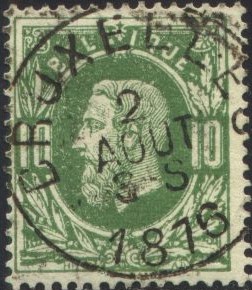
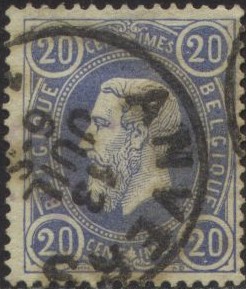
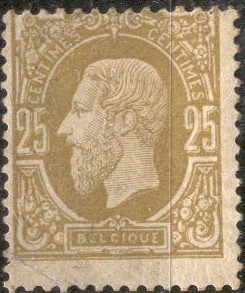
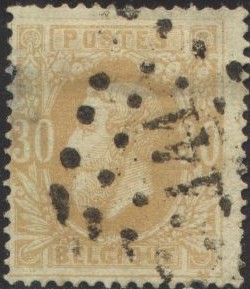
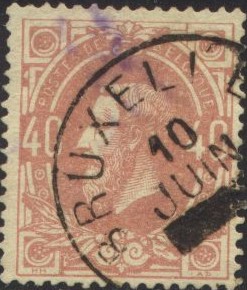
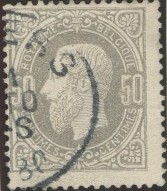
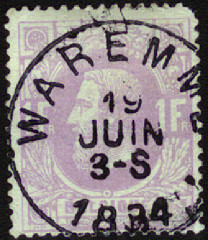
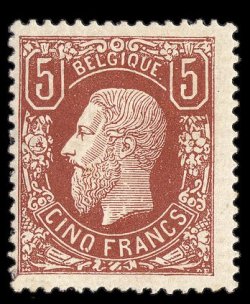
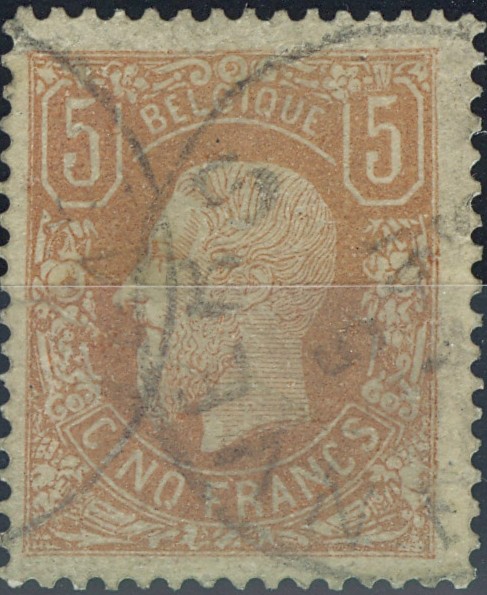
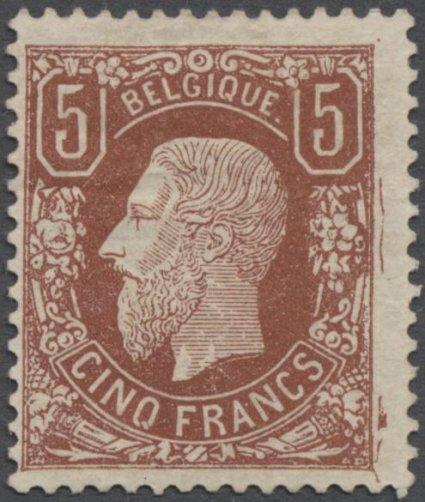
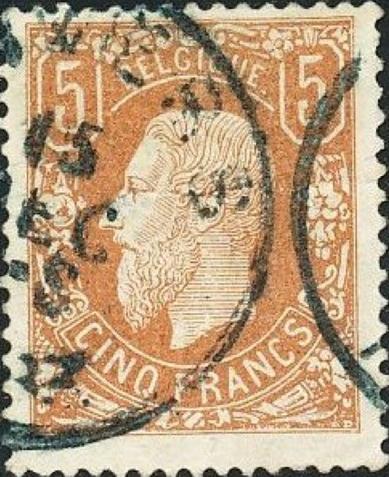
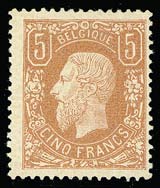
Return To Catalogue - Belgium 1849-1868 - Belgium 1893-1914 - Belgium 1915 onwards
Currency: 100 Centimes = 1 Franc
Note: on my website many of the
pictures can not be seen! They are of course present in the cd's;
contact me if you want to purchase them: evert@klaseboer.com.
For stamps of Belgium issued from 1849 to 1868 click here.
10 c green 20 c blue 25 c yellow 30 c brown 40 c red 50 c grey 1 F violet 5 F brown (1878, 2 shades of colour)
For the specialist: these stamps are usually perforated 15, but the 10 c and 25 c also exist perforated 14, the 10 c, 25 c and 30 c also seem to exist imperforate (rare).
Value of the stamps |
|||
vc = very common c = common * = not so common ** = uncommon |
*** = very uncommon R = rare RR = very rare RRR = extremely rare |
||
| Value | Unused | Used | Remarks |
| 10 c | *** | vc | |
| 20 c | R | c | |
| 25 c | *** | c | |
| 30 c | RR | ** | |
| 40 c | RR | ** | |
| 50 c | RR | *** | |
| 1 F | RR | *** | |
| 5 F | RRR | RRR | Shades: 1878 yellow brown, 1881 redbrown. |
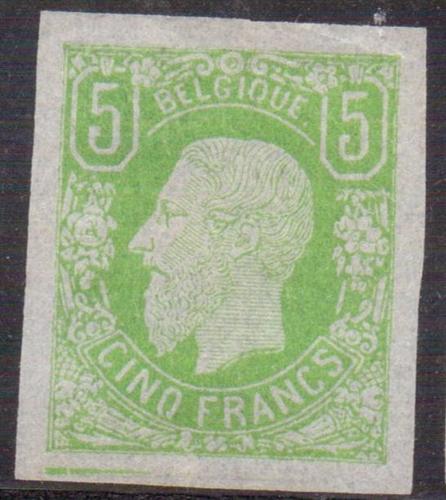
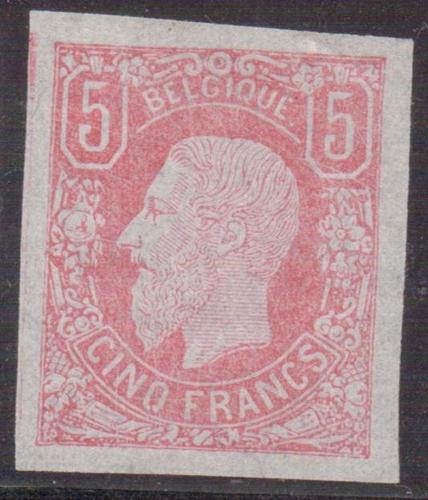
I've been told that these are essays in green and red of the 5 F
value. I'm not sure if this is true.
Sites with interesting information about forgeries of this issue (especially the 5 F): http://users.skynet.be/philately/1869/1869-faux.html and http://fauxtimbres.skynetblogs.be/. Also the book 'Les Timbres Belges Faux et Truques' by M.G.Slagmeulder.
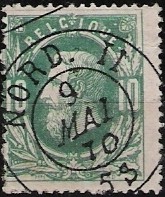
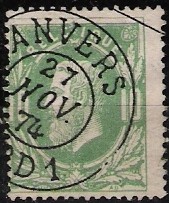
Forged cancels 'NORD II' and 'ANVERS NORD 1' on 10 c values
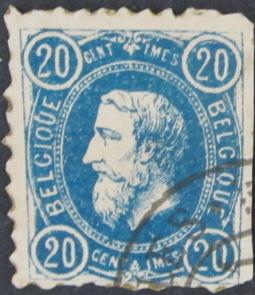
Forgery of the 20 c value. Cut from some kind of souvenir sheet?
The 5 F is very rare (30.000 stamps in red-brown colour were
issued and 18.000 in another shade of yellow-brown only). This is
probably the reason that dangerous forgeries of this stamp are
known to exist (at least 17 different, some from improved
plates). Among the forgers that made forgeries of these stamps
are Fournier, Sperati and Venturini. Fourteen of these forgeries
are described in the book of M. Slagmeulder: 'Les Timbres Belges
Faux & Truqués' (104 pages) or 'Les Timbres Faux de
Belgique' (1955, 157 pages).
These stamps were designed by H.Hendrick and the engraving was
done by A.Doms of the stamp factory (Zegelfabriek) in Mechelen.
The initials 'HH' are found in the left bottom corner and the
initials 'AD' in the right bottom corner of the 5 F stamps.
Distinguishing characteristics of the genuine 5 F:
1) There is a very typical delta-shaped ornament in to the left
of the eye of the King. In many forgeries this ornament has a
different shape.
2) On top of the second 'E' of 'BELGIQUE' there should be only
one line (not a V-shaped ornament as in some forgeries).
There exists a badly printed 'Faux de Gand' which has the shading lines on the face going upwards instead of going downwards (1st forgery listed in Slagmeulder. Sorry, no image available yet).
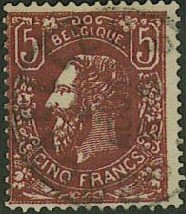
Primitive forgery, 'R' of 'FRANCS' too wide, foot of both '5's
too big and many other differences. This is the only copy of this
forgery I've ever seen and it does not appear to have been listed
by Slagmeulder.
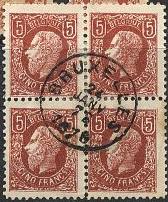
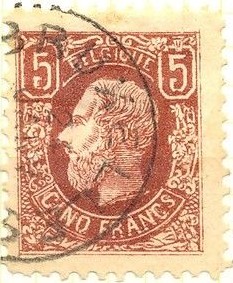
The 3rd forgery listed in Slagmeulder (Faux de Gênes). The
design is quite badly done, the '5's are too wide and the 'S' of
'FRANCS' is too small. Here a block of four cancelled with
'BRUXELLES 24 JANV 7S 1876'. It looks as if a curved line is
going through the word 'FRANCS'. The dot behind 'BELGIQUE' is
missing?
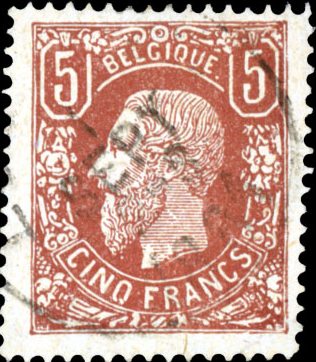
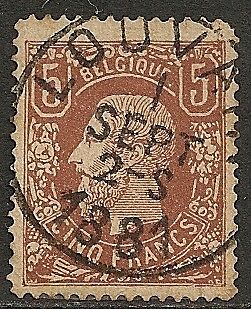
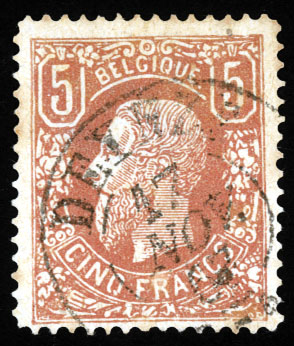
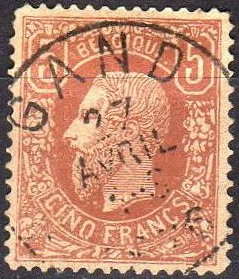
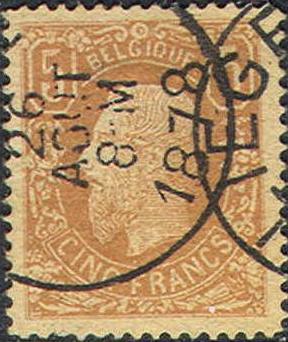
Fournier forgeries, with the forged 'LOUVAIN 1 SEPT 2-S 1887'
cancel, with the Deynze cancel ('DEYNZE 17 NOV 67'), Gand cancel
('GAND 27 AVRIL 1-S 1876') and finally 'LIEGE 26 AOUT 8-M 1878'.
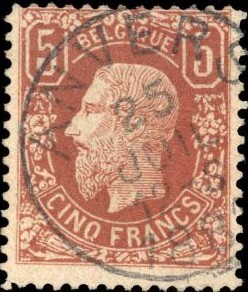
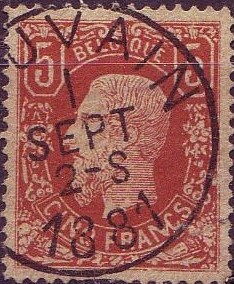
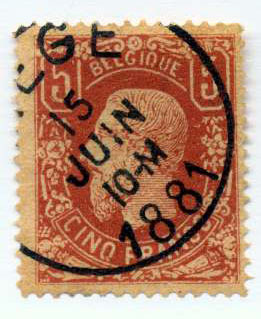
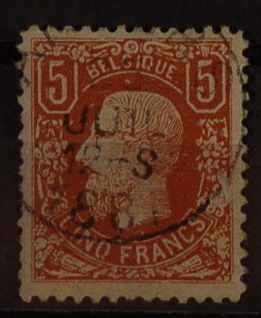
Different type of Fournier forgeries, the 'f' shaped ornament
above the 'C' of 'CINQ' is not separated in two parts. The first
one has a 'ANVERS 25 JUIL 12-S 1881' cancel, the next ones the
Louvain cancel and Liege cancels as shown below. There is a patch
of brown ink filling up the white space between the outer
framelines above the 'GI' of 'BELGIQUE'. The 'L' of this word is
slanting backwards too much.
For example the 5 F is known to be forged by Fournier, or at least sold by him, some sources (Philatelic Forgers, their Lives and Works by V.Tyler) say that actually Oneglia produced the most dangerous Fournier forgery. The cancels that can be found in 'The Fournier Album of Philatelic Forgeries' are: 'GAND 27 AVRIL 1-S 1876', 'LIEGE 26 AOUT 8-M 1878', 'LOUVAIN 1 SEPT 2-S 1881', 'DEYNZE 17 NOV 67' (date before the stamps were even issued!) and 'LIEGE 15 JUIN 10-M 1881'. Fournier offers two varieties of the 5 F in his 1914 pricelist; the 5 F redbrown and the 5 F pale brown for 2 Swiss Francs each as first choice forgeries. The cancel 'ANVERS 25 JUIL 12-S 1881' is listed in Slagmeulder, but not shown in the Fournier Album.

Forged Fournier cancels as shown in a Fournier Album of
Philatelic Forgeries, reduced sizes. Any cancel earlier than 1878
on a 5 F stamp must necessarily be a forgery, since the stamp was
only issued on 6 March 1878.
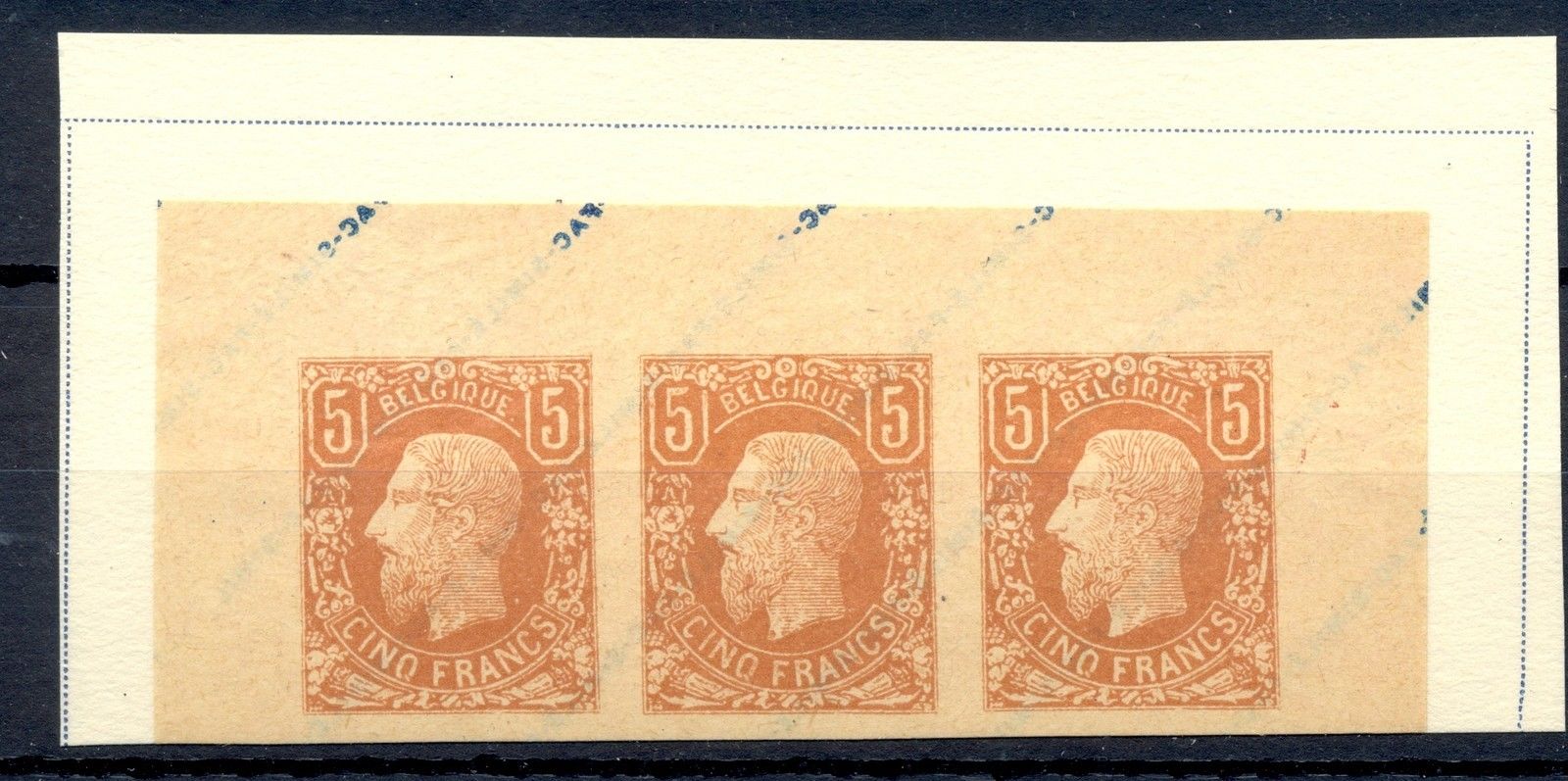
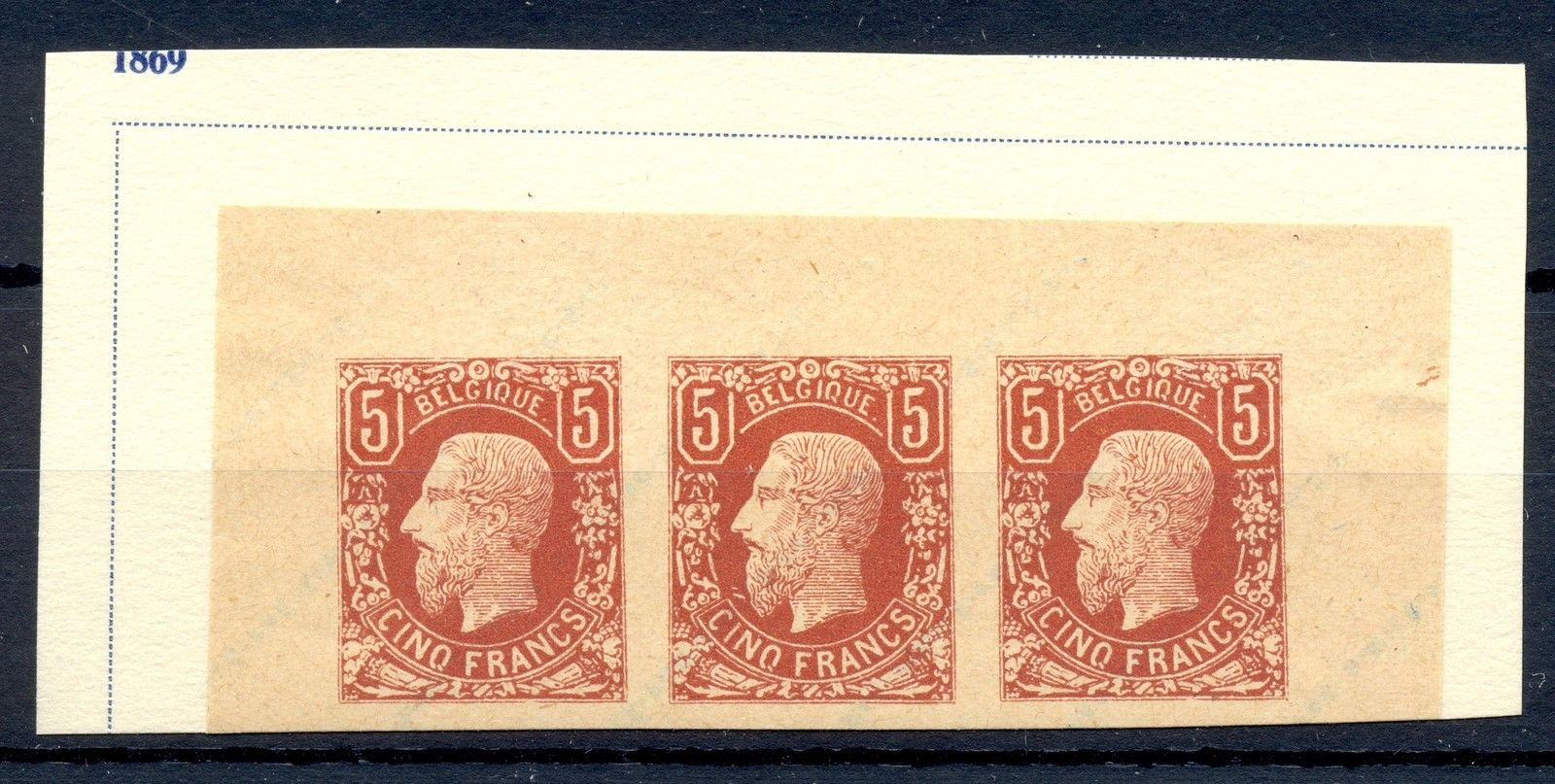
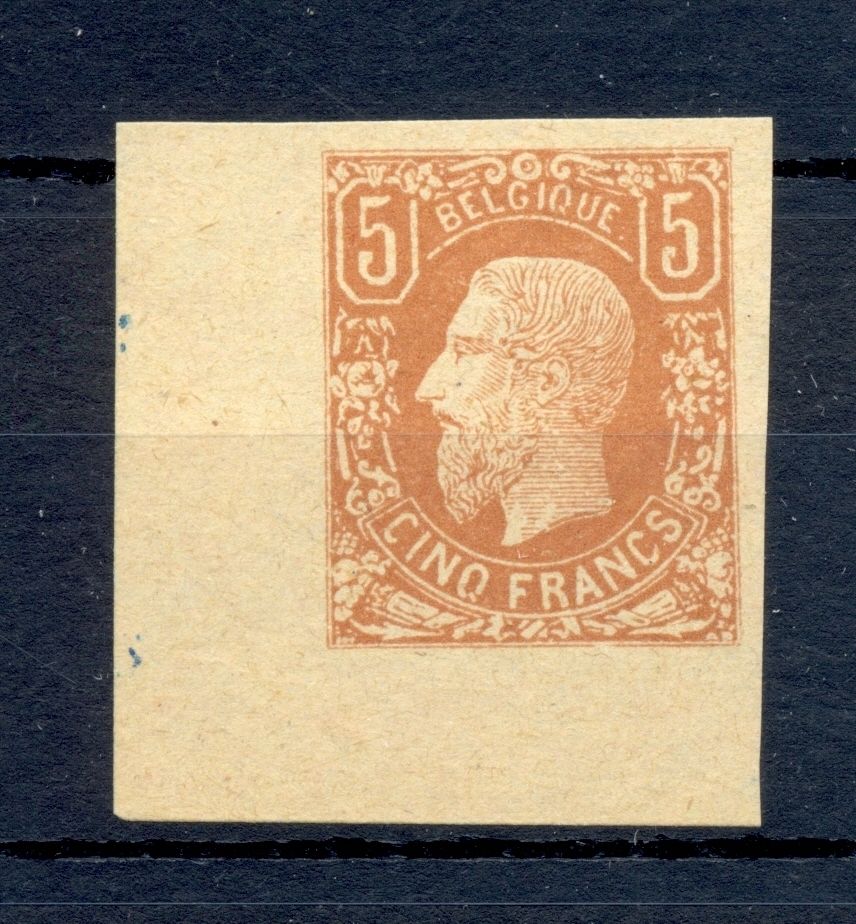
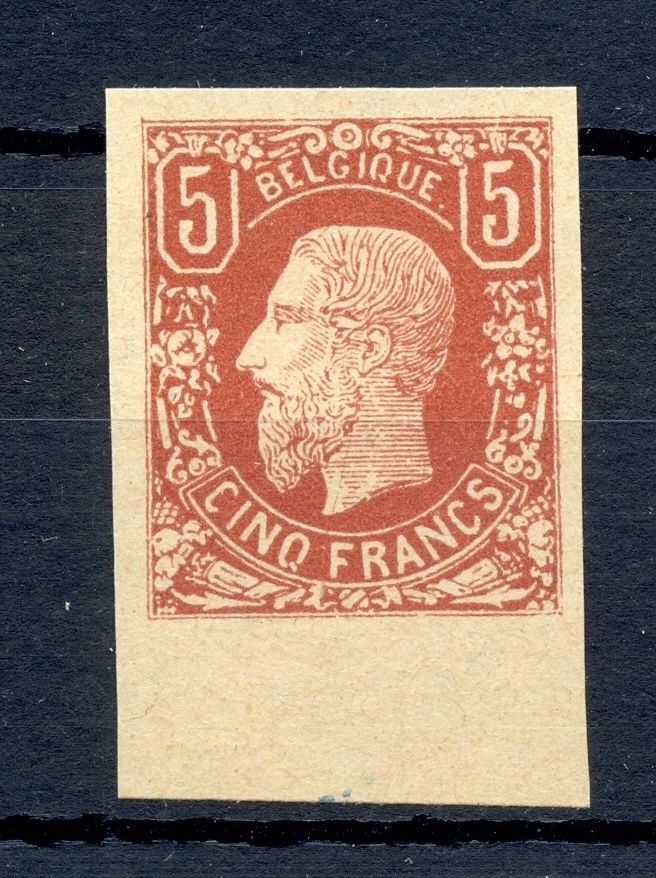
Fournier forgeries, some of them taken from the Fournier Album of
philatelic forgeries.
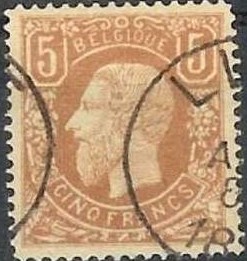
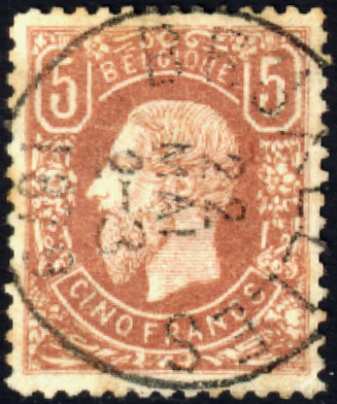
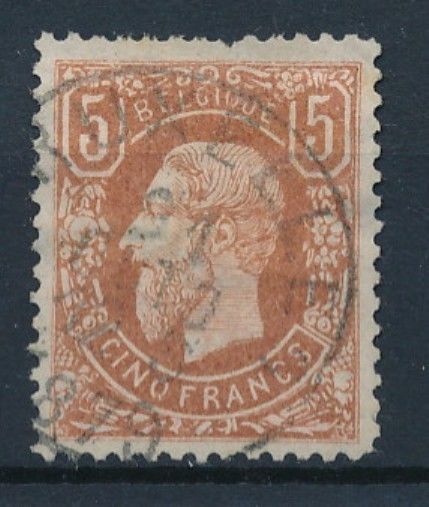
Forgery with 'CINQ FRANCS' written too small. Possibly with a
'LIEGE 26 AOUT 8-M 1878' cancel (I've seen others with this
cancel; this is the same cancel as shown in the Fournier Album ).
It is listed as the 12th forgery in the Slagmeulder book. The
site http://fauxtimbres.skynetblogs.be/,
also shows this forgery with a 'BRUXELLES 22 MAI 2-3 1878' cancel
as in the second scan. I've also seen this forgery with a 'ANVERS
25 JUIL 12-S 1881' cancel (as the Fournier forgery). The dot
behind the word 'BELGIQUE' is missing?
Peter Winter forgeries:
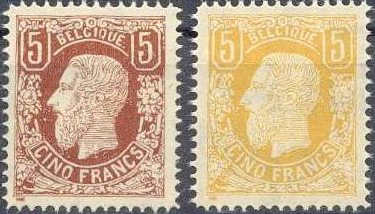
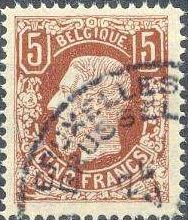
(Three forgeries with wrong perforation and 'FAUX' written at the
bottom left)
The above two forgeries have wrong perforation (it should be 15), I think they were made by Peter Winter. I have seen them either uncancelled or with the 'BRUXELLES BRUSSELS 24....' cancel. I've also seen them in pairs of two or a stamp with a white stamp attached to it. Note that outside the frame at the left bottom corner the word 'FAUX' (= forgery) is written. Also note that the top of the 'G' of 'BELGIQUE' is quite badly done, when compared to a genuine stamp. Note, the very 'pointed' perforations, which doesn't match in the corners. They are often offered (in rather large quantities) on Ebay, so many of these forgeries must exist. I've also seen them with the word 'FAUX' scratched out from the design.
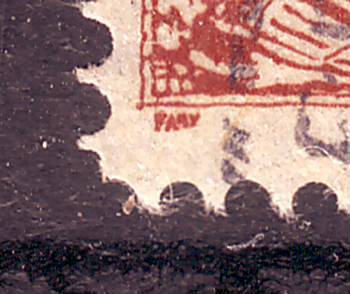
The word 'FAUX' written at the left bottom corner.
I also know that Sperati made forgeries of the 5 F. He forged both colour shades of this stamp. Two different kind of forgeries were made by him (reproductions 'A' and 'B'). In the so-called 'reproduction A' there is a smaller dot behind the dot behind 'BELGIQUE', also the curved brown label containing the word 'CINQ' has an extension into the white line above the 'N' of this word, among some other minor differences. In 'reproduction B' there is a white dot between the 'A' and the 'N' of 'FRANCS' (click on the stamp below to see this). Reproduction A exist in both colour shades, reproduction B only in the yellow-brown shade.
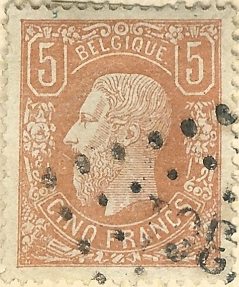
(Reproduction B of Sperati, image obtained from Richard Frajola's
website: http://www.seymourfamily.com/rfrajola/Sperati/speratiindex.htm ); there is a rather large white dot
between the 'A' and 'N' of the word 'FRANCS'.
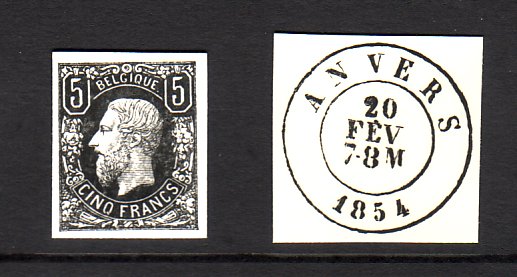
Sperati blackprint and forged cancel "ANVERS 20 FEV 7-8M
1854"
Sperati used genuine cancels for his forgeries (he probably bleached the image of a lower value, so the cancel and the paper would be genuine).
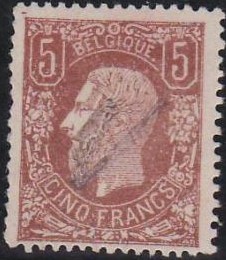
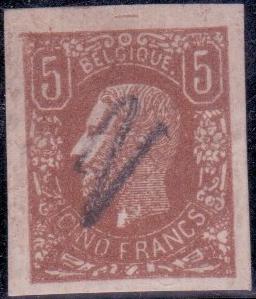
Other forgery of the 5 F; perforate and imperforate. Both with
pencancel.
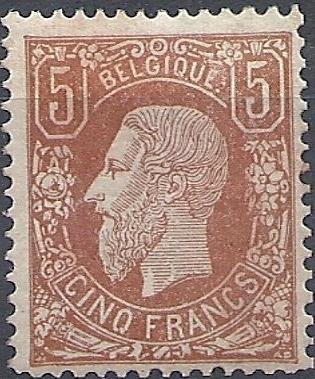
The line under the horn under the 'NC' of 'FRANCS' should have a
break, this forgery does not have this break.
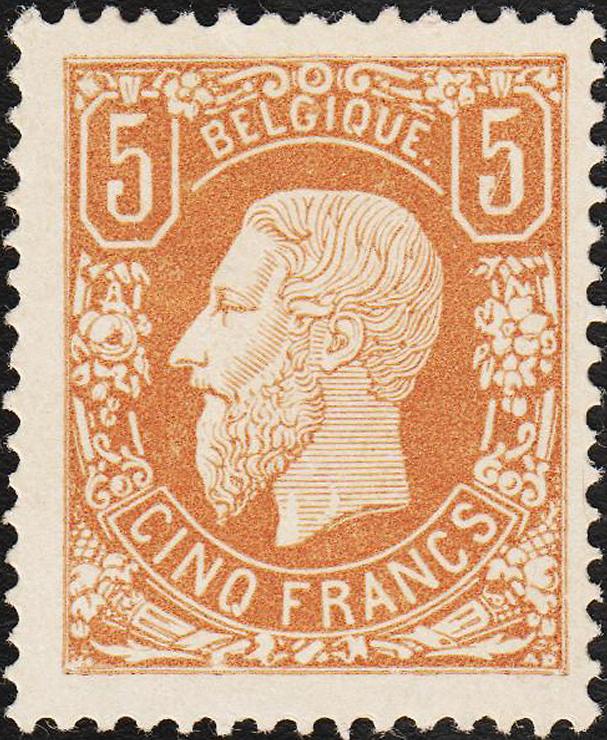
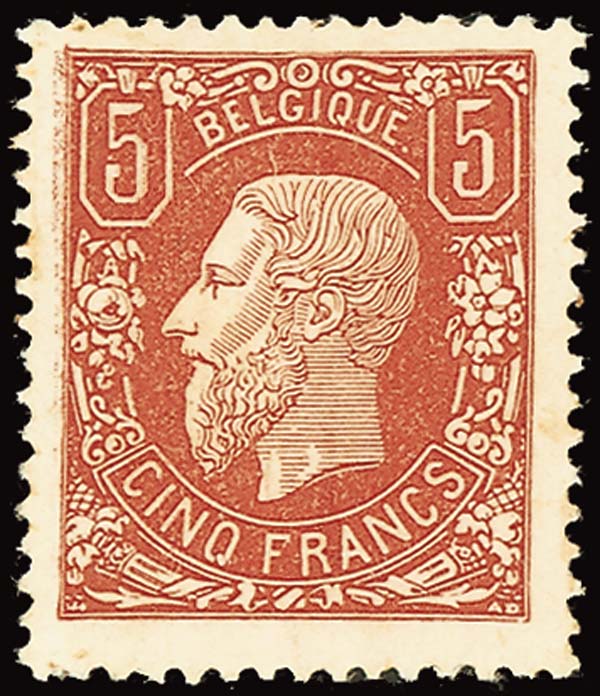

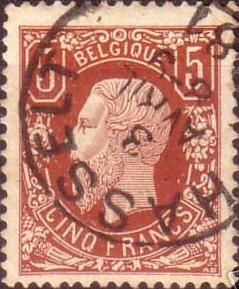
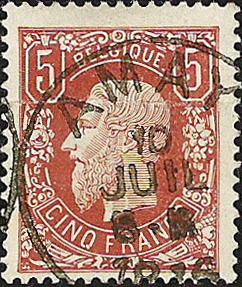
Forgery with an 'A' instead of a 'delta' in the ornaments left to
the eye of the King (see zoom-in at the right). Also there is a
'wedge shaped' ornament above the second 'E' of 'BELGIQUE'. There
is only a line in the genuine stamp. The 'AD' in the lower right
corner is very clear. This forgery is listed as the 7th forgery
in the book 'Les Timbres Belges faux & trucques' by M.G.
Slagmeulder. Often, this forgery has the bottom left corner badly
perforated (one hole missing, see first scan). According to http://fauxtimbres.skynetblogs.be/,
the 9th forgery of his book is actually the same as the 7th
(there are two lines on the second 'E' of 'BELGIQUE' in this
forgery, but this has sometimes been painted over to make it one
line as in the genuine stamps). I've seen a copy of this forgery
with old cracked gum. I've also seen this forgery in the light
brown shade (with very bad perforation). It exists with forged
cancel 'HASSELT 3 AVRIL 8-9 81' and 'AMAY 10 JUIL 8-M 1876'.
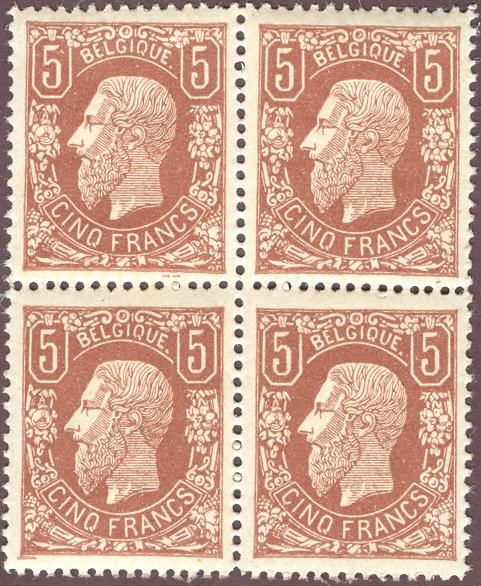
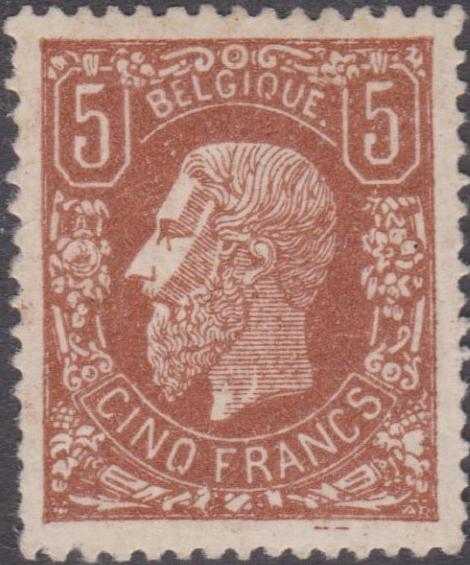
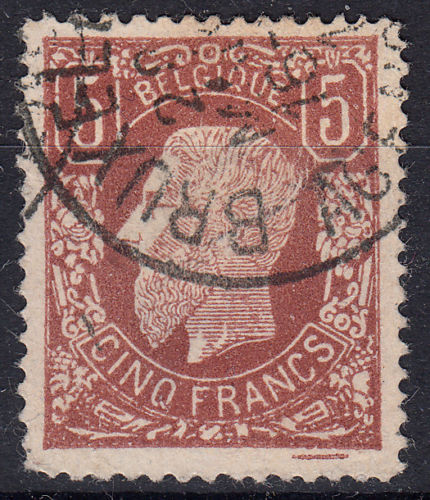
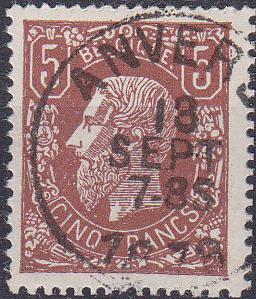
A block of four forged 5 F stamps (11th forgery in the book of
Slagmeulder). An 'A' instead of a 'delta' in the ornaments left
to the eye of the King (see zoom-in at the right). Also there is
a 'wedge shaped' ornament above the second 'E' of 'BELGIQUE'.
There is only a line in the genuine stamp. The shading on the
face of the King continues all the way to his lips. The 11th
forgery (the third and fourth image shown above) closely
resembles the 7th forgery. The 'AD' in the lower right corner is
not as clear in these forgeries as in the 7th forgery and there
is more shading on the cheeks of the King in this forgery. It
exists imperforate, in blocks of four, uncancelled and cancelled
('LIEGE 25 JUIN 5-6', 'ANVERS 1 JUIN 1878' and 'BRUXELLES AGENCE
28 MARS 16-?')
The 5 F stamp is also known to be forged from a cut out of a 'day of the stamp' stamp of 1978. They can easily be recognized by the cancel 'ZEL... 1 AVRIL 9-10 1878'.
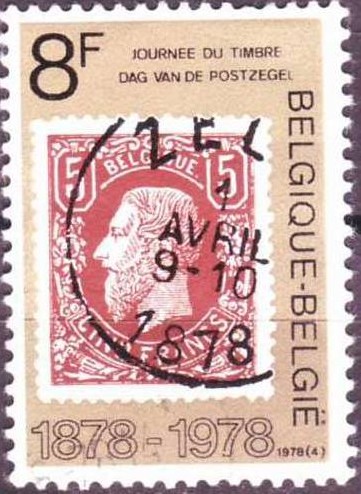
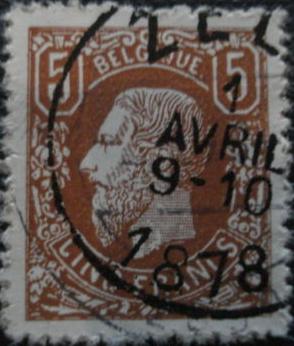
1978 stamp from which forgeries are known to have been made. The
cancel will immediately reveal this forgery. Next to it such a
forgery with faked perforation.
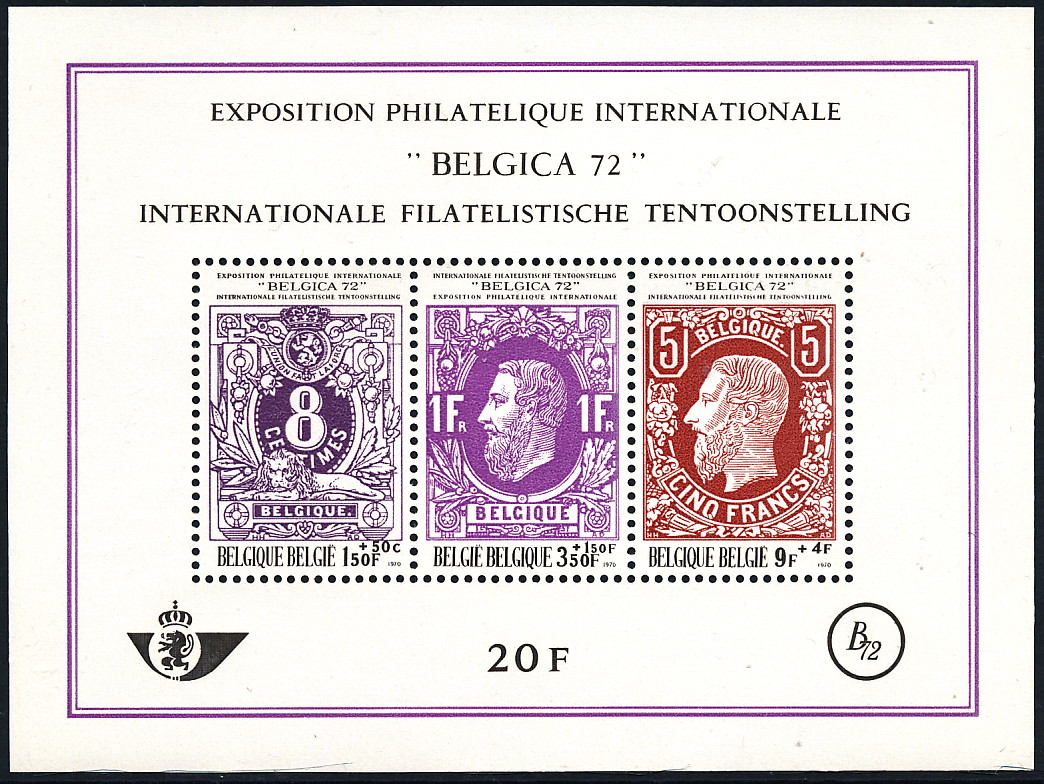
A 1972 Belgica exhibition sheetlet.
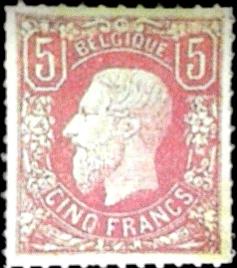
Other modern forgery; note the werid squarish perforation.
10 c red 20 c blue 25 c blue 50 c violet
Value of the stamps |
|||
vc = very common c = common * = not so common ** = uncommon |
*** = very uncommon R = rare RR = very rare RRR = extremely rare |
||
| Value | Unused | Used | Remarks |
| 10 c | *** | c | |
| 20 c | *** | * | |
| 25 c | R | *** | |
| 50 c | R | *** | |
10 c red on blue 20 c olive 25 c blue on red 35 c brown 50 c yellow 1 F brown on green 2 F violet As 35 c type, but with small tab attached (1893)
10 c brown 10 c red 20 c green 25 c blue 35 c brown 50 c brown 50 c grey 1 F red on green 1 F orange 2 F lilac on red 2 F violet
The small attachment with inscription 'NE PAS LIVRER LE DIMANCHE NIET BESTELLEN OP ZONDAG' could be used to prevent the delivery on sunday. With the removement of this attachment the sender of the letter did not object to deliver the letter on sunday. Stamps without tab are worth less. These stamps are all perforated 14.
Value of the stamps |
|||
vc = very common c = common * = not so common ** = uncommon |
*** = very uncommon R = rare RR = very rare RRR = extremely rare |
||
| Value | Unused | Used | Remarks |
Without Tabs |
|||
| 10 c | * | vc | |
| 20 c | *** | c | |
| 25 c | * | vc | |
| 35 c | *** | * | |
| 50 c | ** | * | |
| 1 F | RR | ** | |
| 2 F | *** | *** | |
| With Tabs | |||
| 10 c brown | * | vc | |
| 10 c red | * | vc | |
| 20 c | ** | c | |
| 25 c | ** | c | |
| 35 c | *** | * | |
| 50 c brown | *** | ** | |
| 50 c grey | ** | * | |
| 1 F red on green | *** | *** | |
| 1 F orange | R | *** | |
| 2 F lilac on red | R | *** | |
| 2 F violet | R | ** | |
Mute cancel:
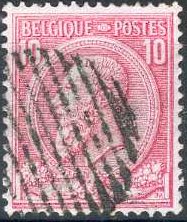
I have seen postal stationery of the type with tab: 10 c red, 10 c brown and 25 c blue on red. The tab could be crossed out with a pen (since it could not be detached as in the stamps). I have seen postal stationery in the design without tab as well: 10 c red and 25 c blue on red.